Kitchen Sink Buying Guide
Picture yourself in your kitchen. Maybe you're making dinner, maybe you're hunting for a midnight snack; you might even be preparing brunch. Chances are that at some point during the course of your visit, you'll be using your sink. Ask yourself: do you enjoy using it? Is it too deep, or too shallow? Do you wish you had a single, large bowl? Or do you long for the familiar convenience of a double-bowl sink? Do you look at your sink and smile, or sigh? Whether you're renovating or just need a new sink, the options today are many. Our goal with this guide is to help you clarify the situation and find the perfect sink: the one you and your family can use, abuse, and occasionally look at with admiration.
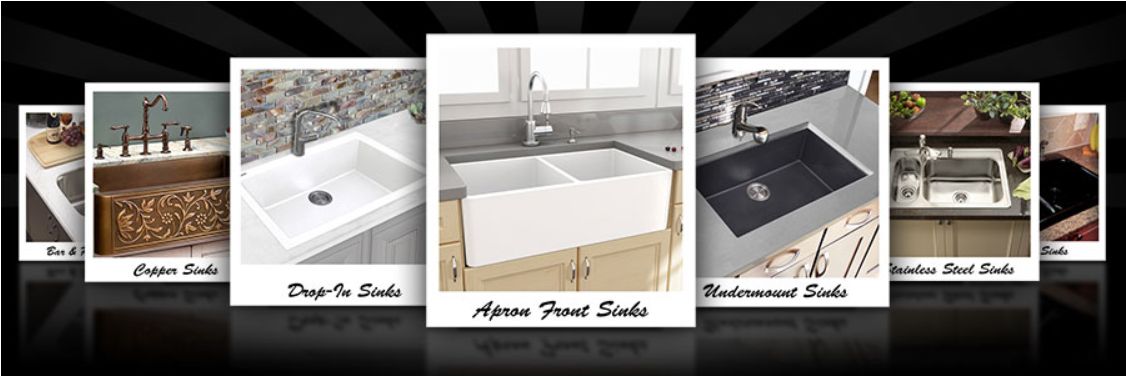
Your primary concerns when purchasing a new sink are the installation type, the size and configuration of the sink, and the material it's composed of. Our buyer's guide provides an overview of these options, placing you on the path to your perfect kitchen sink - and by extension, your perfect kitchen!
Installation Considerations
There are four primary mounting options for kitchen sinks: Drop-In, Undermount, Flat Rim, and Apron-Front.
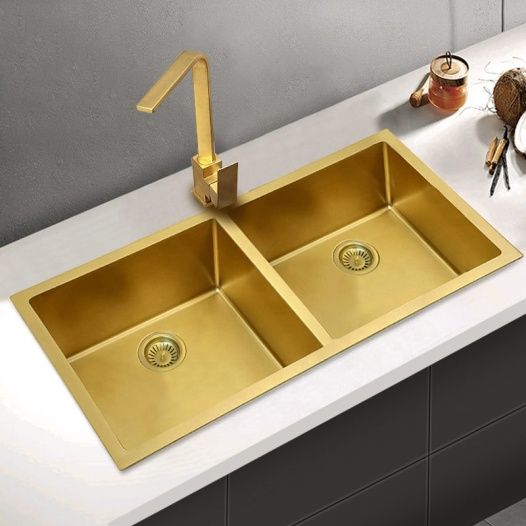
Drop-in
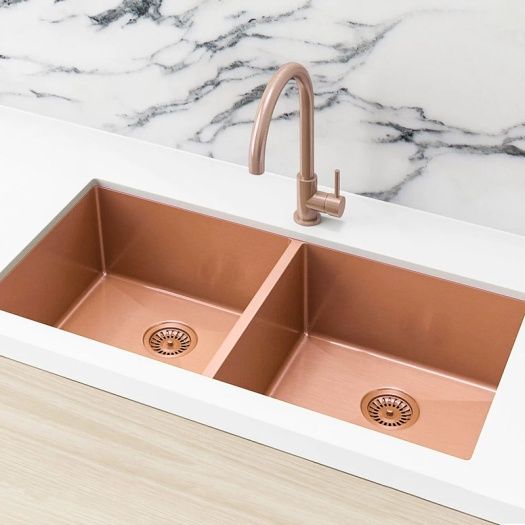
Undermount
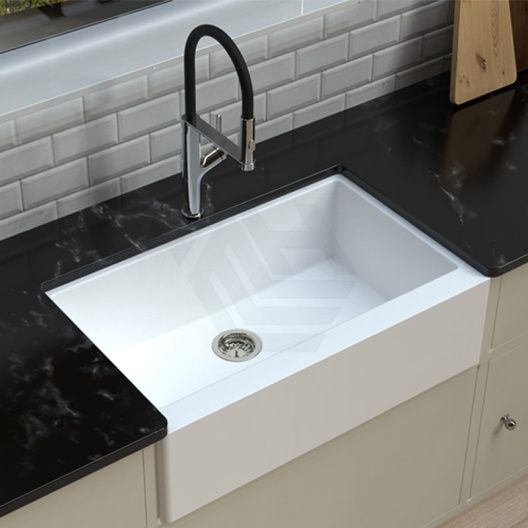
Apron Front
Drop-In
Drop-in sinks (also known as self-rimming or top-mount) work with most counter materials and are the simplest to install, potentially saving you money on installation costs. This is because all that's really needed is a properly sized cut-out in the counter and a sealant. These sinks have a lip which rests on the counter surface, supporting the weight of the sink. Depending on the material and design, the lip may be raised only a few millimeters from the countertop, or closer to an inch. This not only breaks the flow of the counter, it also means debris from the countertop can't be easily swept into the sink as would be the case with an undermount sink. Water and grime can get trapped between the rim and countertop (or build up around it), which is a major drawback for some. However, with proper installation and regular cleaning, this should not present much of a problem.
Undermount
Undermount sinks are mounted beneath the counter using clips, brackets or adhesive. Because the weight of the sink (and everything in it) will be hanging from the underside of the counter, correct mounting is of chief importance. It is highly recommended that undermount sinks be professionally installed to ensure there is proper support. Due to the level of support required for these sinks, they are not recommended for laminate or tile counters, which do not have the integrity of solid counter materials. Undermount sinks can be more expensive than their drop-in equivalents, and with professional installation, can result in a higher final cost. If you decide to use an undermount sink, be aware that the sink will usually not have a faucet ledge and that faucets and other accessories must be installed into the countertop or onto the wall, possibly increasing installation costs.
An important consideration with undermount sinks is the amount of "reveal" you desire. This refers to the amount of the sink's rim that remains visible after installation. A positive reveal means that the cut-out is larger than the sink: the sink's rim is visible below the countertop. A negative reveal is the opposite: the cut-out is smaller, leaving an overhang of countertop around the sink. A zero reveal has the edge of the sink and the countertop flush, providing a straight drop into the sink from the counter. The reveal is entirely dependent upon personal preference, but does require extra planning and, in the case of a zero-reveal, extra finesse in the installation.

Flat Rim
Flat rim sinks are often used for tiled-in installations when you want your sink to be flush with the top of the countertop. The sink is mounted on top of the stabilizing layer of the countertop which is usually cement board attached directly on top of a plywood base. The sink is adjusted on the stabilizing layer to match the height of the thickness of the finished tile for flush mounting with the countertop. Or the sink can be adjusted to allow 1/4 round tile to drop onto the surrounding edge of the sink.
Flat rim sinks installed onto tile countertops are preferred by many as an alternate to the higher cost of granite, quartz or soapstone counters. Tiled-in flat rim sinks allow the user to be able to wipe off debris from the counter directly into the sink without any hassle and the design options and colors are limitless. Flat rim sinks are also commonly used as undermount sinks or for laminate countertops such as Formica® when used with a metal sink rim.
Apron Front
Apron-front sinks (also known as farmhouse sinks) have seen a resurgence in recent years, and thanks to newer stainless steel and stone models, are now found in both modern and traditional kitchens. Originally a single large, deep basin, today's apron-front sinks are also available in double-bowl designs. They work well with many types of counters, provided the base cabinetry has been properly modified for the depth of the sink and reinforced to support its full, filled weight (fireclay and stone models especially can be very heavy). Apron-fronts slide into the cabinetry, and are supported from underneath. Here again, professional installation is highly recommended.
Beyond the vintage charm, one of the main benefits of an apron-front sink is the lack of counter space in front of the sink. Depending on your height and that of your counter, this may provide for a more comfortable sink use experience since you should not need to lean over to reach into the sink. When choosing any sink, remember to also consider the depth of the sink bowl. Bowls can be 10 inches deep or more, which could be a backache waiting to happen for some.
Sink Size & Configuration
Kitchen sinks today come in many different shapes and sizes, with all kinds of design features and accessories. While it may be easy (and fun!) to get caught up in all of these options, it's important to keep a few key questions in mind: how do you use your sink? Do you have a dishwashing machine, or are you the dishwasher? How often (if ever) do you use large pots and pans? A realistic assessment of what you'll be doing with your sink will help you best determine its size, configuration and material.
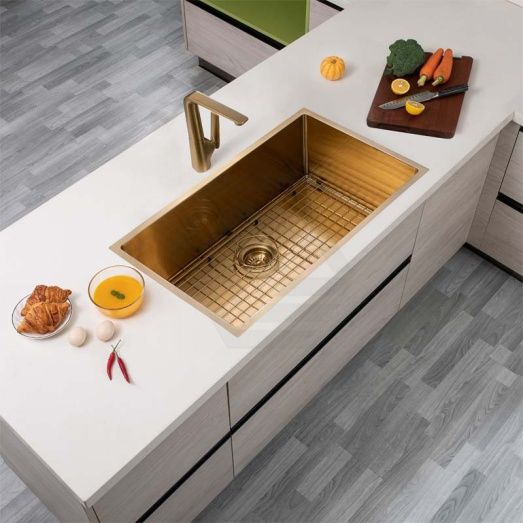
Oversized Single Bowl
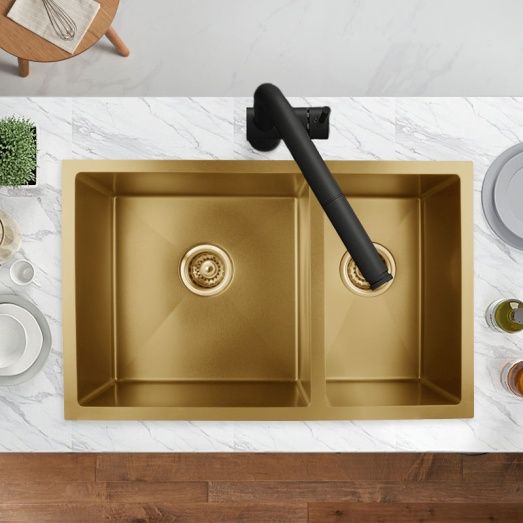
Double Bowls
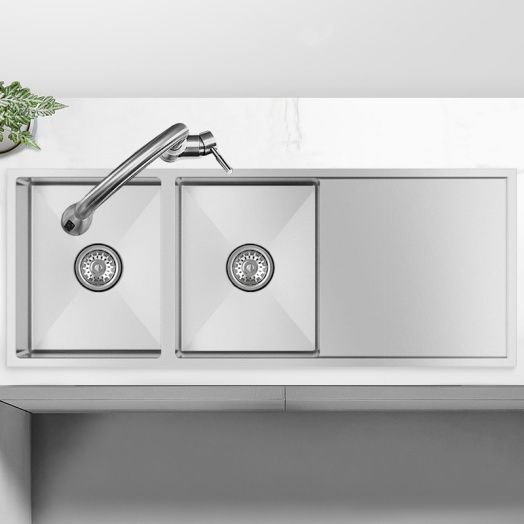
Double Bowls with Drainer Board
One of the most obvious options you'll decide on is the number and size of bowls in your sink. Here, it's important to think about your dishwashing habits and the types of things you'll be washing. Though it does ultimately come down to personal preference, many who wash their dishes by hand find the double-bowl design most convenient, as it allows them a space for soaking and washing, and another for rinsing or drying. Fans of garbage disposers might also prefer two bowls, one being smaller than the other. Triple-bowl sinks are also available, with one basin usually reserved for a disposer, another for food preparation. The size of each bowl for double or triple bowl sinks can vary, with some sinks having all bowls the same size and others with one large and one small, or two large and one small in the case of triple bowl sinks.
Unfortunately, double and triple bowl designs can be inconvenient for larger baking sheets, pots, and pans. Those who regularly use larger cookware might be better served by a large single-bowl sink, which provides ample room for large pieces to be comfortably cleaned within it. Those still wanting the convenience of a double-bowl sink could simply use a plastic dishpan while washing, effectively turning the one large basin into two when needed. Let's not forget about prep sinks either! A smaller sink placed elsewhere in the kitchen for food prep and quick clean-up could be invaluable, especially in larger kitchens where you may be working in more than one area.
When deciding upon the number and size of the bowls, remember to consider the overall size of the sink. In smaller kitchens especially, you'll need to consider how your sink fits into the counter and how the size of your sink will affect available counter space. Even the standard 22" x 33" kitchen sink size may be too big for smaller kitchens - and if you need a smaller sink, consider how that will affect bowl size. For example, your kitchen may be better served with a 28" single bowl rather than a 28" double bowl where nothing will fit because the bowls are too small. Regardless of kitchen size, a bigger sink will mean less counter space for food prep and small appliances, but if you have plenty of extra counter space, you do most of your food prep in the sink, or you choose a sink with a built-in prep area that might not be a concern for you.
Zero or small radius corners can make a big difference in the size of the sink as well. Coved (rounded) corners definitely make cleaning easier, but also make the bottom of the sink bowl smaller. If you like to fit the entire pot or cookie sheet into the sink when washing up, zero/small radius sinks may be the right answer for you. Be aware though that zero radius corners can be trickier to clean, so if that's a concern for you, a small radius sink where the edges are only slightly curved will make cleaning up easier.
Another size consideration is faucet and accessory placement. Smaller sinks may not have enough room across the back to fit certain faucet configurations (e.g., widespread, side spray) or accessories requiring extra faucet holes like a soap dispenser or a dishwasher air gap (which is a code requirement for many locations) - so if this extra room is necessary or you just really, really want a side spray faucet and a soap dispenser, make sure these considerations are part of your decision when choosing the size of your new sink.
Sink Materials
Deciding what material your sink will be made of should also be considered in the light of your practices and habits. For instance, sinks that experience heavy traffic are better served by more durable materials like stainless steel or granite composite. If you often use heavy cookware, you may not want to go with a porcelain-enameled sink, which is liable to chip or scratch when subjected to enough weight and force.
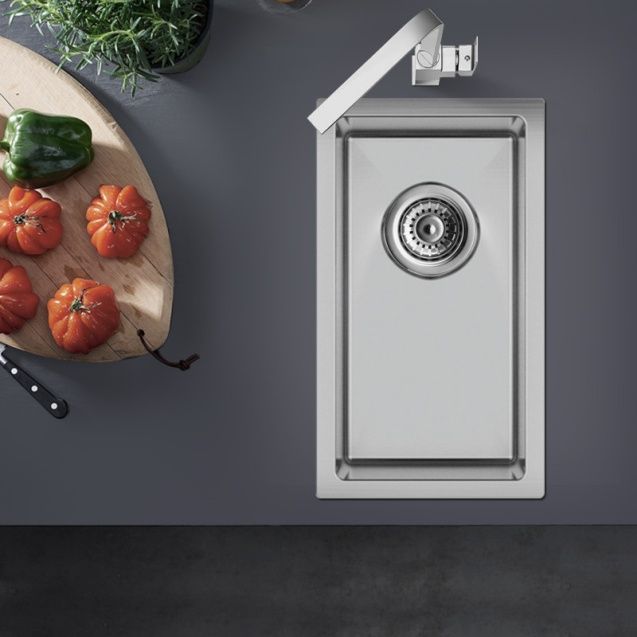
Stainless Steel
Stainless steel sinks are renowned for their durability and longevity, as well as their cost-effectiveness. Stainless steel is rated by gauge, often between 16-gauge and 22-gauge. The lower the number, the thicker and higher quality the sink. 22-gauge is the "bare minimum" to look for (builder quality) and many people are happy even with 20-gauge sinks, but we strongly recommend choosing an 18-gauge or better sink as the majority of our customers have been much happier with the quality of these sinks despite the higher cost.
As durable as they are, stainless steel sinks do require regular cleaning to maintain their good looks. They can easily show water spots (especially if you have hard water), and can scratch, especially when abrasive materials or cleaners are used. They are difficult to stain, but can lose their luster if not wiped dry regularly. Despite the care required to keep these sinks looking great, they remain among the most popular of choices and are compatible with pretty much any kitchen design.
Porcelain-Enameled Cast Iron & Steel
Enameled cast-iron sinks have been a staple since the beginning, and for good reason. Another durable material, they also feature an attractive, glossy finish and are available in many colors. Porcelain enamel does require a fair degree of attention in its maintenance and cleaning, to avoid the problems of scratching, etching and staining. Abrasive cleaning methods will scratch the finish, while strong acids will etch it, potentially leading to discoloration. A porcelain enamel finish can also be chipped, exposing the iron underneath and leading to rust. This is of particular concern with heavy cookware and less-than-conscientious family members who are prone to throwing things into the sink. If you treat them right, however, these are probably the best, toughest sinks you can buy - and they're often priced that way. A cast iron sink is a purchase you likely won't regret.
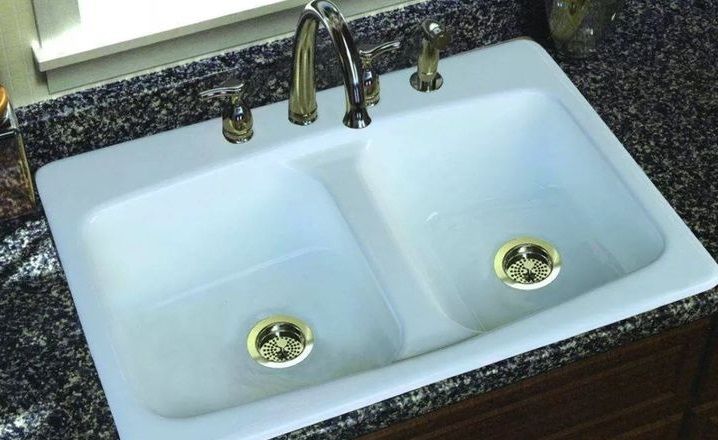
Enameled steel sinks use the same principle, but with a different underlying metal. The steel is not quite as strong or heavy as cast iron, bringing the price down substantially. While enameled steel is viewed as more of a budget option, it can add beauty and durability to your kitchen - and with proper care, can last you for years to come.
Fireclay
Similar in appearance to porcelain-enameled cast-iron, fireclay sinks are composed of clay and minerals, and fired at extremely high temperatures, giving them exceptional strength and heat resistance. We offer fireclay sinks in a variety of styles and colors.
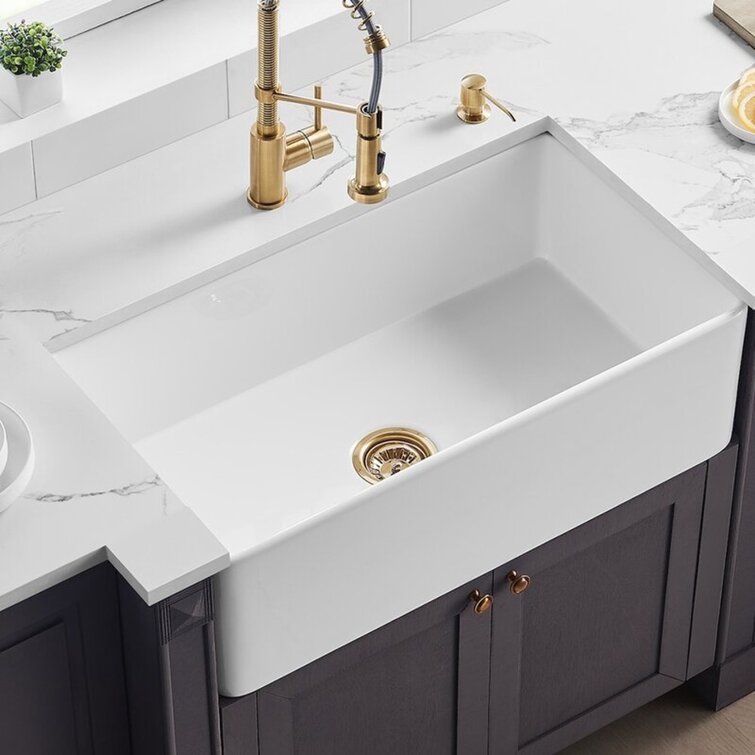
Their ceramic non-porous surface is also naturally resistant to mildew, mold, and bacteria - making them an excellent option for the kitchen. Like cast-iron, fireclay can chip with enough weight and force, but it does not run the risk of rusting when this happens due to its solid nature. In addition, be aware that vibrations from garbage disposers can crack or "craze" (create cracks in the glaze) the sink and consequently we don't recommend using disposers with fireclay sinks. If having a garbage disposer is a must for you, a more forgiving sink material is probably a better option.
Because these sinks are so solid and durable, they can be extremely heavy, and of course larger sinks will be heavier. You may need to reinforce your cabinetry prior to having these installed.
Acrylic
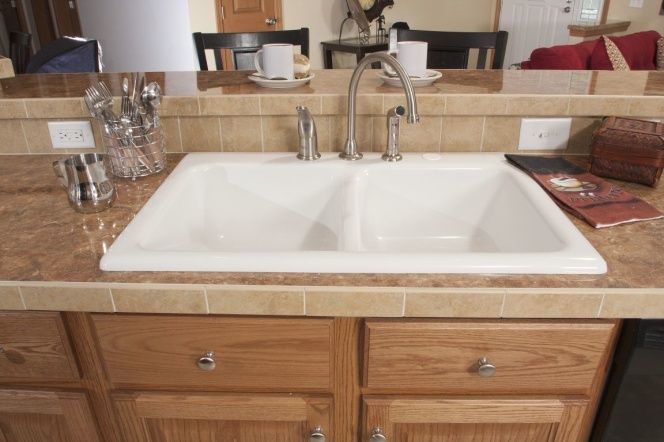
Acrylic sinks are made of plastic, fiberglass and resin. Acrylic is a cost-effective and attractive material, available in any number of colors and designs. Being lightweight, an acrylic sink can be easily installed with almost any counter material and is a great option for retrofits, rental homes, and other situations where you want the beauty and durability of a quality sink without the weight. Because they're composed of a single, solid material, moderate scratches can be sanded and polished out, and the finish is resistant to staining and rust.
One of the primary benefits of acrylic is their resilience - you're not very likely to break a lot of dishes in an acrylic sink because of the give when something is dropped into the sink. Despite this resiliency, acrylic sinks do have their drawbacks, chief of which is their general intolerance to heat. However, some manufacturers have found ways to mitigate this problem and the SolidCast acrylic sinks we offer are able to withstand temperatures up to 450 degrees Fahrenheit.
Copper
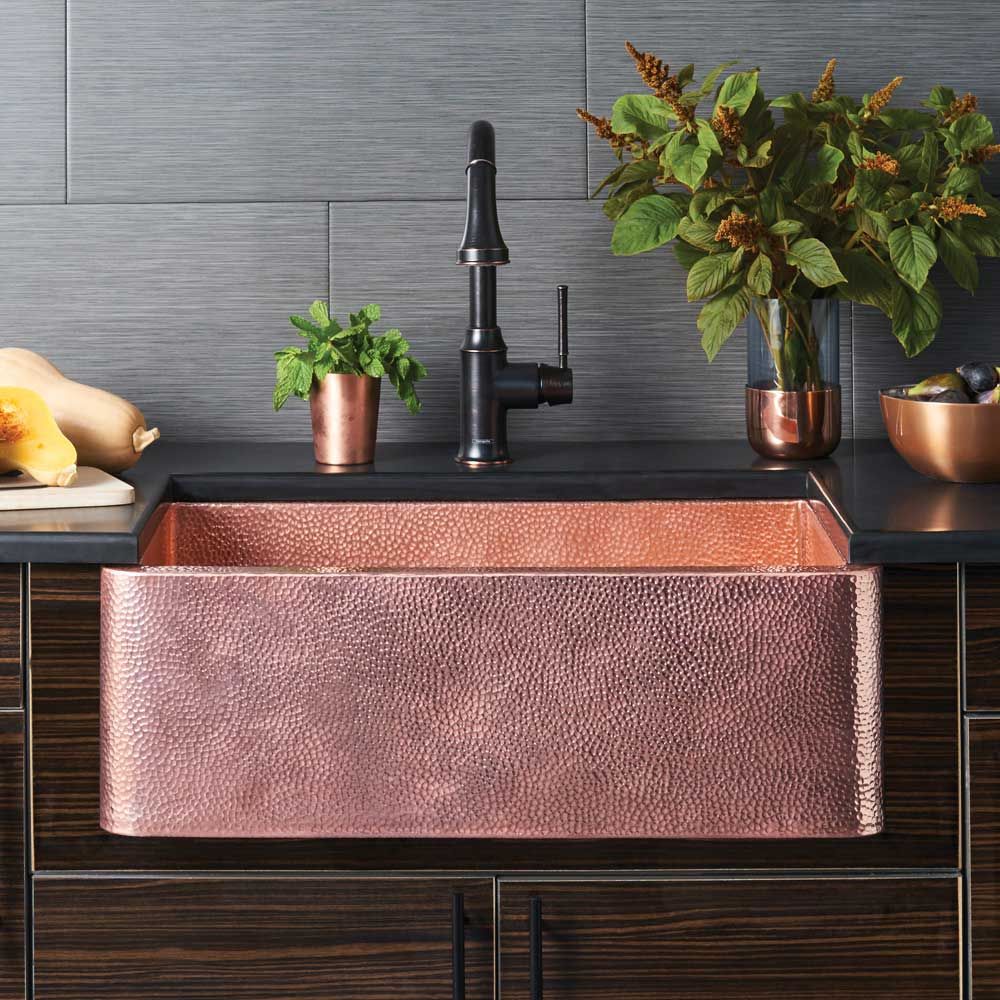
Though they are on the more expensive side, copper sinks are a beautiful and beneficial option for your kitchen. In addition to their distinctive looks, copper sinks will not rust, and exhibit anti-microbial properties. Though sink manufacturers must register with the EPA to guarantee this anti-microbial distinction, studies have shown that bacteria will not survive more than a few hours on a copper surface.
Copper is also a highly reactive material, and its appearance will change over time as its natural patina develops. The nature of this patina can vary depending on the copper itself and the environment it's found in, but often results in a darkening of the initially bright, "raw" finish, and can even lead to hues of blue and green. Those who wish to keep the initial look can polish their sink, which will seal in the finish, but at the cost of the copper's anti-microbial properties (as a barrier will be created between the copper and its environment).
Solid Surface
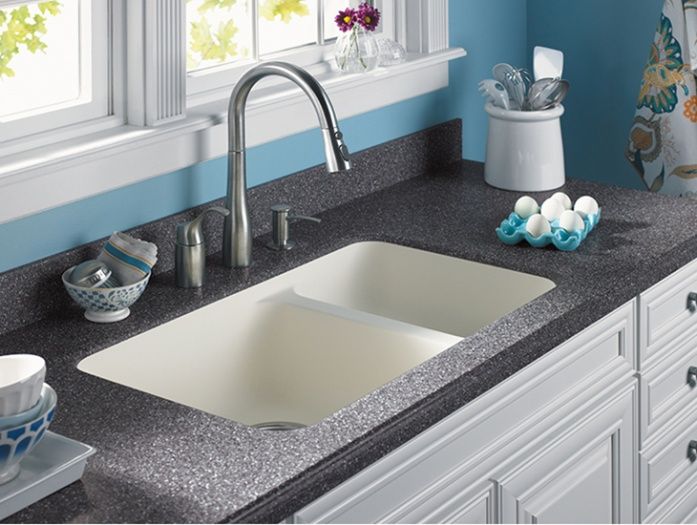
A non-porous alternative to natural stone, solid surface is made of resin and minerals. Used for countertops, sinks and tubs, it is highly versatile, durable, and reparable. As with acrylic sinks, scratches on a solid surface sink can be sanded and polished out. Their composition is uniform throughout, so not only can the sink be chipped without much concern, it can also be cleaned without much concern; only metal scouring pads are off-limits according to the manufacturer of our solid surface sinks, Swanstone, due to the severe scratching they can cause. Most other normal scratches can be easily buffed out.
Solid surface is also a relatively yielding material, which is more forgiving to dropped dishes than something like cast-iron or natural stone. Temperatures up to 450 degrees Fahrenheit are tolerated, making solid surface a relatively worry-free option for your kitchen sink. Beware, however, that any damage to a solid surface sink will require professional repair, which can be costly.
Stone (Granite/Composite/Marble)
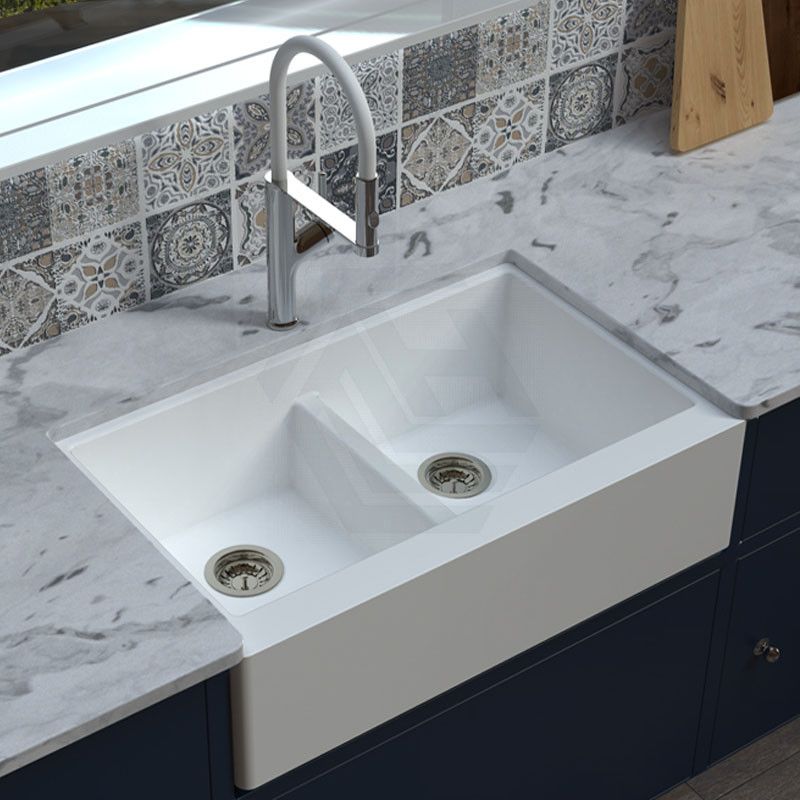
Stone sinks are a uniquely beautiful option for your kitchen. We offer a few different types: 100% Marble, 100% Granite, and Granite Composite (usually composed of 85% quartz granite and 15% acrylic resin). As can be expected, these sinks are quite heavy, and require special preparation of the cabinetry for installation. Granite and marble sinks are often found in the apron-front style, to further show off their looks. These sinks can have a distinctive chiseled face showcasing the rough, natural beauty of the stone, or an intricately carved one. Those aiming for more simplicity can opt for a smooth, polished face matching the sink's interior. Remember, however, that natural stone is porous, and will require initial sealing and regular resealing to protect against stains.
Where granite and marble sinks run on the expensive side, granite composite offers a more cost-effective alternative. Like their natural stone counterparts, granite composite sinks have a high resistance to heat (our composite sinks are rated to 530 degrees Fahrenheit). Both are also dense, making them less noisy than other sink materials like stainless steel. Though granite composite should not require resealing, like many other sinks, lighter colors can be subject to stains, while darker colors can more readily show hard-water spots if not regularly wiped dry.
There are indeed many things to consider when purchasing your kitchen sink, and we hope we've helped you in choosing the right sink for your kitchen. Our chief advice is to remember to always keep in mind your own personal needs and preferences, as these will ultimately dictate your level of satisfaction with your sink (or anything you purchase). Tastes and trends change, but utility does not - go with what's comfortable, useful, and makes you happy!
Post time: Jan-07-2022

